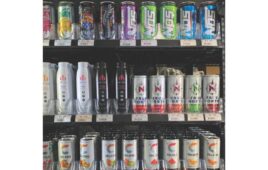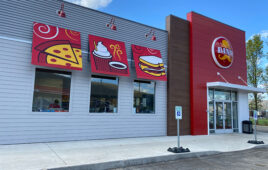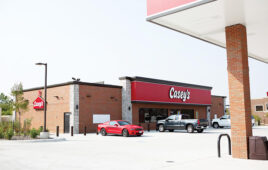 Buoyed by a constant stream of new products and equipment upgrades as well as focus on time-tested procedures, roller grill and pizza continue to appeal to convenience store customers.
Buoyed by a constant stream of new products and equipment upgrades as well as focus on time-tested procedures, roller grill and pizza continue to appeal to convenience store customers.
By Marilyn Odesser-Torpey, Associate Editor
Made-to-order foods may get most of the buzz, but there’s a good reason why so many convenience stores still offer roller grill products and pizza ready to go. The reason is because they sell.
“Roller grill remains one of the top foodservice categories in convenience stores,” said Brad Duesler, president and CEO of Middleton, Wis.-based Food Concepts Inc., a retail merchandising solutions provider. “The number of grills that are put into stores increases by more than 5% annually.”
Duesler explained that manufacturers are backing up roller grill programs with a plethora of new and innovative products ranging from hamburger and chicken items to hash browns and pizza. They are also offering co-merchandising and brand support programs, including trade dress and appetizing display photos.
As the breadth of roller grill products has increased, the basic technology of the equipment has evolved. For example, products such as tornados and egg rolls require more friction to roll on the grill than hot dogs so equipment manufacturers have added coarse particulates to the rollers to facilitate easy turning, he said.
To ensure that all items are cooked to proper temperature before they are displayed, some grills have thermal drawers or preheat chambers. Others are digital, allowing the preprogramming of cooking and holding temperatures, Duesler pointed out.
ROLLING ALONG
Roller grill generates between 30-40% of the foodservice revenues at Buchanan Energy’s Bucky’s Convenience Stores in Nebraska, Iowa, Missouri and Illinois, said the company’s Food Service Director Mike Cairns. Out of a total of 80 stores, 75% have roller grill programs.
The average store has three 50-count grills. In the larger stores, the roller grill program operates under Bucky’s proprietary B-Grillerzz Dogs brand.
“We regard roller grill as the anchor for our foodservice program,” Cairns said.
In the morning, the planogram for the grill has 10 items. Four of them are breakfast-oriented items.
“In the morning, hot dogs and other non-breakfast items often sell out before our breakfast items do,” Cairns said.
During the lunch and dinner dayparts, the grills feature 12 items, including four hot dog and sausage link products, tornados, taquitos and roller bites.
Bucky’s leverages the novelty of limited time offers (LTOs) by offering them at a special 99-cent price for two months. The regular price of roller grill items is $1.59 or two for $2.50. Popular LTOs are added to the regular menu at full price and Cairns said that even with the price rise, these items maintain 80% of their sales. Two recent “huge hits” that went this route were tamales and egg rolls.
The roller grills are situated on a large island along with up to six wells for chilled condiments, ketchup and mustard pumps and free chili and cheese. New condiments are introduced to complement specific LTOs. Examples include sweet and sour sauce for the egg rolls and marinara sauce for a meatball roller bite.
Cairns pointed out that retailers cannot afford to make the mistake of trying to reduce waste by putting out too few items or leaving them on the grill for too long.
“You’re going to have 15-20% waste and, while it needs to be managed, it cannot be totally eliminated,” he said. “We manage it with build-to’s and logs on which and we record all of our waste. The formula we use is what we cook, less spoils, plus two. If you only put out what you sold the week or day before you will never grow incremental sales.”
Roller grills are also front and center at 15 of the 16 Simonson Station Stores in North Dakota and Minnesota. Hot dogs, particularly the all-beef 3:1 franks and cheddar dogs, are the biggest sellers all day long, according to Dane Simonson, the chain’s operations manager.
Depending on the size of the stores, they can have two-foot, three-foot or two two-foot grills. The stores offer a total of between 10 and 12 roller grill items, six to eight of which are core items and four that change “to keep people interested,” Simonson said. Many of the stores have refrigerated prep tables with space for different condiments such as fresh onion, pickles, relish, banana peppers, jalapeños, sauerkraut and red onion.
Signage changes frequently to “call out” either an existing roller grill item or a new one. To encourage customers to buy multiples, the stores offer one roller grill item for $1.69 and two for $3.
PIPING HOT PIES
Pizza is a key component of the foodservice program at Cubby’s Convenience Stores. The company has more than 30 stores in Nebraska, Iowa and South Dakota. At 28 of those stores it operates one of two different pizza concepts.
In 19 of the stores are Godfather’s Express units, which sell mini (five-ounce) and full-size pies.
“Godfather’s is based in Omaha and it’s a strong brand in this part of the country,” said De Lone Wilson, Cubby’s president.
For nine other stores in areas where geographic conflict made it impossible to put in Godfather’s locations, Cubby’s created its own pizza brand about seven years ago. Whole pies are available, but in place of doing mini pies like the Godfather’s program, the Cubby’s brand sells slices.
“We sell a lot of breakfast pizza and the minis were too much food for breakfast,” he said.
Another reason is that customers tend to view the mini as a meal, while slices are regarded as snacks and sell well throughout the day, not just at traditional mealtimes. Eliminating the mini version also allows Cubby’s to stock only one size crust.
While the Cubby’s brand pizza started out as just filler for places where the company couldn’t put Godfather’s, it is quickly developing into a full-scale program, Wilson noted.
“We have developed our own policies and procedures, promotions, specialty pizzas, and we’re even going through the process of designing our own boxes,” Wilson said.
The brand has been very successful, Wilson said. In some stores it does just as well as the Godfather’s pizza. For both programs, the pies are topped and baked to order or are available for grab and go from the warmer display.
Like Cairns from Bucky’s, Wilson cautioned about the problems that can arise when stores neglect to put out enough product in an effort to avoid waste.
“You have to make a commitment to a pizza program and not be afraid to throw product away,” he said. “If you’re not throwing some away, you’re not making enough.”
Herndon Oil Corp. has the Hunt Brothers Pizza concept in three of its 17 stores in southeastern Alabama. The stores sell whole pies, oversized slices—about a quarter of the whole pizza—called “The Hunk” and breakfast pizzas, said Mike Martin, Herndon Oil’s president.
“We also do a good business in refrigerated take-and-bake pizzas that are eligible for Electronic Benefit Transfer purchases,” Martin said.
Part of the company’s promotional strategy is running a price-oriented promotion four times a year. Examples are two-fers and a five-cent-per-gallon rollback on gas prices with the purchase of a whole pie.




